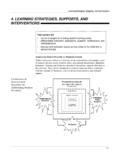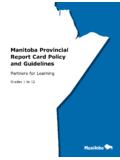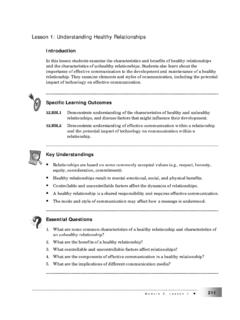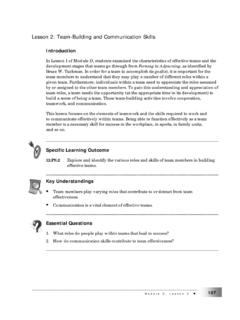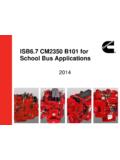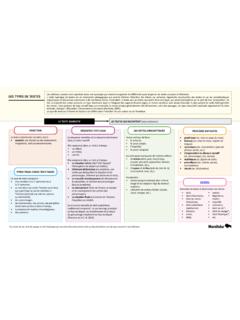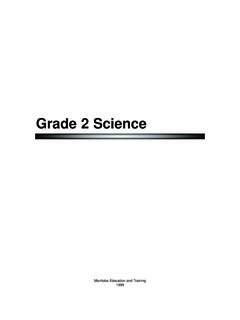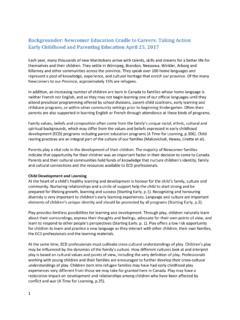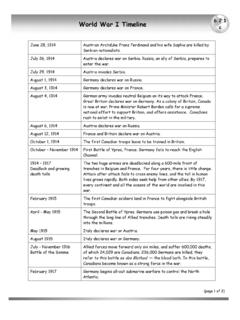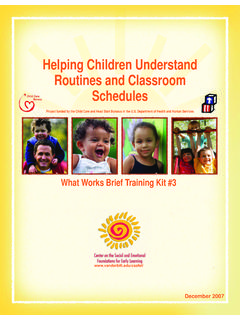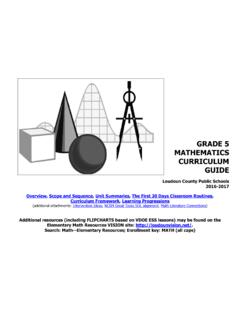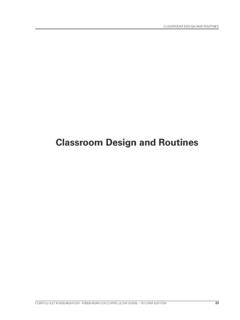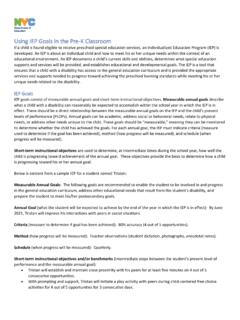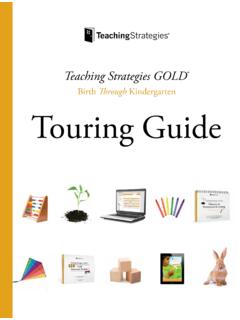Transcription of Rethinking Classroom Assessment with Purpose in Mind
1 RethinkingClassroom Assessmentwith Purpose in MindAssessment forLearningAssessment asLearningAssessment ofLearningRethinkingClassroom Assessmentwith Purpose in MindAssessment forLearningAssessment asLearningAssessment ofLearning2006 Manitoba Education, Citizenship and Youthii Rethinking Classroom Assessment with Purpose in MindManitoba Education, Citizenship and Youth Cataloguing in Publication Data Classroom Assessment with Purpose in mind : Assessment for learning, assessmentas learning, Assessment of learningIncludes bibliographical references. ISBN 0-7711-3499-11. Educational tests and measurements. 2. Academicachievement Evaluation. 3. Students Evaluation. 4. Students Rating of. I. Manitoba. Manitoba Education,Citizenship and 2006, the Crown in Right of Manitoba as represented by theMinister of Education, Citizenship and Youth. Manitoba Education,Citizenship and Youth, School Programs Division, 1970 Ness Avenue,Winnipeg, Manitoba R3J 0Y9.
2 Every effort has been made to acknowledge original sources and to complywith copyright law. If cases are identified where this has not been done,please notify Manitoba Education, Citizenship and Youth. Errors oromissions will be corrected in a future print resource is also available on the Manitoba Education, Citizenshipand Youth website: < > Rethinking Classroom Assessment with Purpose in Mind iiiAcknowledgementsThis document has been developed by Dr. Lorna Earl and Dr. Steven Katz fromAporia Consulting, in collaboration with the Western and Northern CanadianProtocol for Collaboration in Education (WNCP) Assessment team, which ismade up of representatives from each of the member provinces and this guide has been a collaborative process, with WNCP team memberssharing in shaping the document, developing the ideas, and locating examplesfrom within their own Partners: Alberta Education British Columbia Education Manitoba Education, Citizenship and Youth Northwest Territories Education, Culture, and EmploymentNunavut Department of Education Saskatchewan Learning Yukon Education iv Rethinking Classroom Assessment with Purpose in MindForewordClassroom-based Assessment has tremendous potential to enhance studentlearning.
3 When Assessment is designed with Purpose in mind, learning for allstudents can improve. Manitoba Education, Citizenship and Youth is proud tohave collaborated with its partners in the Western and Northern CanadianProtocol for Collaboration in Education (WNCP) in developing this Classroom -based Assessment document. As implied in the title, Rethinking Classroom Assessment with Purpose in Mind,identifying the Purpose of any Assessment is critical for its effective use. Thisdocument identifies three purposes of Classroom Assessment : Assessment forlearning, Assessment aslearning, and Assessment readers may be more familiar with frameworks that use only twocategories: Assessment forlearning and Assessment oflearning. In thoseframeworks, the category of Assessment forlearning would include ideas relatedto both the Assessment forand Assessment aslearning categories described inthis document. The category of Assessment aslearning is included in RethinkingClassroom Assessment with Purpose in Mindto highlight the importance of theself-monitoring processes students use during learning, which have greatpotential to empower learners and foster ongoing Classroom Assessment with Purpose in Mindis intended to provide aframework for extending thinking, to confirm and to guide changes in effectiveassessment practices, and to foster professional learning.
4 While this resourceoffers some common vocabulary for Assessment , its focus is on ideas, rather thanlabels, that teachers can reflect on, discuss, and try out in classrooms. Thedocument contains highlights from current research, descriptions of assessmentprocesses that enhance learning, case studies from classrooms, and suggestionsfor professional dialogue and are invited to consider Rethinking Classroom Assessment with Purposein Mindin relation to their personal practice, as well as to engage withcolleagues, students, and the community in planning for Assessment that bestpromotes student learning. Rethinking Classroom Assessment with Purpose in Mind vTable of ContentsAcknowledgementsiiiForewordivInt roductionviiSection I: Setting the Stage1 Chapter 1: Why Change Classroom Assessment ?3 Classroom Assessment and Societal Change4 The Effects of Classroom Assessment on Learning5 Classroom Assessment and Its Effects on Motivation6 Using Classroom Assessment for Differentiating Learning 7 Quality in Classroom Assessment8 Chapter 2: Purposes of Classroom Assessment13 Balance and Tensions in Assessment Purposes 14 Planning the Assessment Process15 Reporting16 Assessment Tool Kit16A Vignette of Assessment in Action 18 Section II: Three Purposes of Assessment27 Chapter 3: Assessment forLearning29 What Is Assessment forLearning?
5 29 Teachers Roles in Assessment forLearning29 Planning Assessment forLearning30An Example of Assessment forLearning35 Summary of Planning Assessment forLearning39 Chapter 4: Assessment asLearning41 What Is Assessment asLearning?41 Teachers Roles in Assessment asLearning42 Planning Assessment asLearning 44An Example of Assessment asLearning50 Summary of Planning Assessment asLearning54 Chapter 5: Assessment ofLearning55 What Is Assessment ofLearning?55 Teachers Roles in Assessment ofLearning55 Planning Assessment ofLearning56An Example of Assessment ofLearning61 Summary of Planning Assessment ofLearning65 Section III: Next Steps67 Chapter 6: Embedding and Sustaining Purposeful Classroom Assessment69 Understanding and Motivation70 Capacity: Knowledge and Skills71 Leadership72 School and Community Support for Change73 Nurturing Inquiry Habits of Mind73 Chapter 7: Building Capacity for Enhancing Classroom Assessment75 Professional Learning75 Leadership and Support77 Engaging Parents and Community79 Appendix 1: Template for Planning Assessment82 Appendix 2.
6 Overview of Planning Assessment85 Resources for Further Reading87 Works Cited95vi Rethinking Classroom Assessment with Purpose in MindRethinking Classroom Assessment with Purpose in Mind viiIntroductionWith the goal of enhancing student learning, Rethinking ClassroomAssessment with Purpose in Mindis designed to support teachers inassessing their students effectively, efficiently, and fairly, and to serve as abasis for designing professional learning. It has been produced by theWestern and Northern Canadian Protocol for Collaboration in Education(WNCP), a partnership of provinces and territories1with a mandate toprovide quality education for all students from Kindergarten to Grade 12through collaboration in educational programs and services. Each provinceand territory in the WNCP will use the document within its uniquecircumstances, and will develop local implementation plans and is important to note that Rethinking Classroom Assessment with Purposein Mindis concerned with Classroom Assessment , not large-scaleassessment.
7 All of the provinces and territoriesin WNCP are engaged in one kind of large-scale Assessment program or another, and someshare resources. Large-scale Assessment plays auseful and important role in providing system-level feedback. It is a complement to, and not asubstitute for, Classroom Assessment . This document focusses on the kindof Assessment that is an integral part of regular activity in every Classroom ,every day. It is designed to provide a framework for thinking as teachers,administrators, and professional developers work together over time indeveloping and using Assessment in their classrooms to differentiate andfacilitate learning for all recent years, each of the provinces and territories in the WNCP hasrecognized the power of Assessment for student learning in statements thatreinforce a focus on Assessment for enhancing learning for all are not arguing that one Assessment approach is good andanother bad: the key issue is around fitness for Purpose .
8 (Gipps and Cumming, Assessing Literacies)_____1. Alberta, British Columbia, Manitoba, Northwest Territories, Nunavut, Saskatchewan, and theYukon Territory. viii Rethinking Classroom Assessment with Purpose in MindIntroductionAlthough this document includes many examples, it is not a collection ofassessment tools for teachers to mix and match. Instead, it provides aframework for thinking about the purposes of Assessment , and for creating andimplementing changes to teachers Assessment practices that are consistent withenhancing learning for all students. The notion of a framework for thinking is animportant one; Rethinking Classroom assessmentis about thinking first and doingsecond. Rethinking Classroom Assessment with Purpose in Mind is designed togive teachers an opportunity to both confirm and extend their Classroom Assessment with Purpose in Mindis premised on thebelief that Assessment has various purposes, and that it is important tointentionally design and use Classroom Assessment methods to serve the intendedpurposes.
9 This is not a step-by-step process. Instead, it depends on routineattention to the intended purposes. Changing Assessment will require newindividual and collective capacity for teachers, administrators, and even Yukon Department of Education, workingwith parents and community, strives to developthe whole child .. and provide an educationappropriate to the individual Assessment plays a crucial role inthis goal of assessing the continuouseducational needs and progress of students todirect the teaching and differentiated learningwithin the Classroom . The Departmentencourage[s] independent self-assessors in thequest for life-long learning. (Yukon Departmentof Education, 2004)Northwest Territories Schools are extensions of the cultures andlanguages of the communities they serve, andinvolve the community in the education of theirchildren. In this context, Assessment : must reflect the vision, the values, and the goals of the community; is an integral part of all teaching and learningprocesses in the school, at home, and in thecommunity; is based on the educational needs of allstudents; and measures growth with respect to specific learning outcomes.
10 (Northwest Territories Education, Culture andEmployment, 2001)NunavutIf students are to successfully move on to thenext stage, it is important to build into thelearning environment reflection, self- Assessment and correction. (NunavutDepartment of Education, 2000)British Columbia Teachers use Assessment andevaluation information to provide students and parentswith ongoing feedback; plan further instructional andlearning activities; set subsequent learning goals; identify students who mayrequire intervention. (British Columbia Ministry ofEducation, 2004)AlbertaAssessment, evaluation andcommunication of studentachievement and growth areessential parts of the teaching andlearning process. Each part of theteaching and learning processshould be a positive experience forstudents and promote personalgrowth. Practices should be carriedout in such a way that they supportcontinuous learning anddevelopment. (Alberta Learning,2003)SaskatchewanEvaluation should be an integralpart of the teaching-learningprocess.
